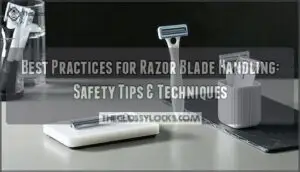This site is supported by our readers. We may earn a commission, at no cost to you, if you purchase through links.

Store blades in dry containers away from humidity, which causes rust and dulling that ruins your shave. Clean blades with rubbing alcohol after each use to prevent bacterial buildup, and immediately dispose of any damaged or excessively dull blades.
Keep your workspace well-lit and your hands completely dry before handling. Most cuts happen during rushed blade changes, so take your time and maintain focus.
These fundamentals prevent injuries while maximizing blade performance, but there’s more to achieving that perfect, safe shave.
Table Of Contents
- Key Takeaways
- Choosing The Right Razor Blade
- Safe Handling of Razor Blades
- Maintaining Razor Blade Sharpness
- Caring for Your Razor and Blades
- Mastering The Art of Razor Blade Handling
- Safety Precautions When Handling Razor Blades
- Hygiene and Sanitation Best Practices
- Razor Blade Storage and Organization
- Advanced Techniques for Razor Blade Handling
- Troubleshooting Common Issues With Razor Blades
- Frequently Asked Questions (FAQs)
- What is the razor and blade strategy?
- How to improve safety razor technique?
- How often should I replace my razor blade?
- Can I use the same blade for different body parts?
- Are electric razors safer than manual razor blades?
- How can I prevent razor burn when using blades?
- Can razor blades be recycled properly?
- Conclusion
Key Takeaways
- Always grip blades by their safe edges, never the cutting surface – Use the pinch technique with thumb and forefinger to maintain control and prevent accidental cuts during installation or removal.
- Store blades in dry, well-ventilated containers away from moisture – Humidity causes rust and dulling that ruins performance, so keep them in dedicated blade banks or cases in dry locations.
- Clean blades with rubbing alcohol after each use and replace when dull – This prevents bacterial buildup and maintains sharpness; dispose of damaged or excessively dull blades immediately.
- Keep your workspace well-lit with completely dry hands – Most cuts happen during rushed blade changes, so maintain focus and take your time for safe handling.
Choosing The Right Razor Blade
Selecting the right razor blade isn’t just about grabbing the first one you see—it’s about finding the perfect match for your skin and shaving style.
You’ll want to evaluate blade material, sharpness, size, and safety features to guarantee both comfort and effectiveness in your daily routine.
Selecting The Best Blade Material
When selecting blade material, you’ll find two primary steel types dominating the market.
Smart blade selection separates smooth shavers from frustrated ones—know your steel, know your shave.
Stainless steel offers excellent blade durability and rust resistance, making it perfect for beginners who want low-maintenance razor blade safety.
High-carbon steel provides superior edge retention and blade sharpness but requires more careful material selection and maintenance to prevent corrosion.
The choice of steel type is vital for achieving superior razor blade sharpness and longevity.
Understanding Blade Angle and Sharpness
Your blade’s angle and sharpness determine whether you’ll glide smoothly or suffer through tugging chaos.
Perfect blade geometry meets precise angle control for maximum cutting efficiency. Understanding razor blade sharpness levels is essential for achieving the best shaving results.
- Blade Angle Impact: Hold your razor at 30 degrees for maximum control and sharpness levels
- Sharpness Testing: Feel for tugging during shaving—dull blades compromise razor blade safety
- Edge Durability: Sharp blades last longer with proper razor blade handling techniques
- Cutting Efficiency: Match blade geometry to your beard’s texture for superior performance
Considering Blade Size and Type
When you’re picking your razor blade, think of it like choosing the right tool for the job—blade size and blade type matter more than you’d expect.
Blade length and blade width affect control and coverage, while edge type determines cutting precision.
Your handle style impacts grip comfort during razor blade handling.
Match sharpness level to your needs—razor blades aren’t one-size-fits-all solutions!
Safety Features to Look for in Razor Blades
Three key safety features transform ordinary razor blades into reliable tools.
Look for blade guards that prevent accidental contact, razor locks that secure blades firmly, and safety edges designed to minimize cuts.
Quality blade materials like stainless steel resist rust, while ergonomic handle design provides non-slip control.
These features make safe razor use second nature.
Safe Handling of Razor Blades
Safe handling of razor blades isn’t just about avoiding cuts—it’s about developing smart habits that keep you injury-free while maintaining your grooming routine.
You’ll master the essential techniques for grip, storage, and protection that transform razor blade handling from risky business into second nature.
Proper Techniques for Picking Up and Holding Blades
Master blade grip using the pinch technique—thumb and forefinger create perfect blade control.
Focus on finger placement away from sharp edges for safe blade handling techniques.
Maintain proper hand position and razor balance while gripping non-cutting sides only.
Use designated tools or cut-resistant gloves to reduce injury risk by 83%.
Never rush during safe blade handling—controlled movements prevent accidents.
How to Store Razor Blades When Not in Use
When you’re ready to put your razor blades away, proper storage protects both you and your blades.
Here’s your game plan for razor blade storage:
- Blade Containers: Use dedicated blade banks or razor cases to keep blades secure and organized
- Storage Safety: Choose dry, well-ventilated areas away from moisture and children’s reach
- Sharp Disposal: Store used blades in puncture-proof containers until proper disposal
Smart blade handling techniques start with where you stash them!
Preventing Accidental Cuts and Injuries
Accidents with razor blades can turn your morning routine into a trip to the first-aid kit. Keep your grip firm and steady – no fumbling allowed.
When a blade drops, resist the urge to catch it mid-air. Instead, grab tweezers or tongs for safe blade disposal.
These razor safety tips for handling sharp objects aren’t just suggestions – they’re your best defense against preventing razor cuts and minimizing blade injuries through smart injury avoidance practices.
Using Protective Gear When Handling Blades
When handling razor blades, protective gear acts as your safety net against unexpected slips.
Essential equipment includes:
- Cut-resistant gloves and finger protectors provide vital barrier protection during blade changes
- Safety glasses shield your eyes from metal fragments or cleaning solution splashes
- Blade handling tools eliminate direct contact, reducing injury risk substantially
Personal protective equipment transforms risky blade handling into controlled, safer operations.
Maintaining Razor Blade Sharpness
A sharp razor blade makes the difference between a smooth, comfortable shave and a frustrating tug-of-war with your facial hair.
Keeping your blades in peak condition isn’t just about performance—it’s about safety, cost savings, and getting the most out of every shave.
The Importance of Regular Blade Sharpening
Your blade’s performance depends on blade maintenance—sharp edges cut smoothly while dull ones tug and irritate skin.
Regular sharpening techniques and edge honing extend blade life, improve safety, and deliver better shaves.
A quality blade sharpener saves money long-term.
Sharpness testing reveals when maintenance is needed, while proper steel selection affects durability and blade geometry performance.
Techniques for Sharpening Razor Blades
Sharp blades make all the difference, so mastering blade honing techniques is essential for razor maintenance.
Try honing on leather strops using gentle, consistent strokes—this edge sharpening method can extend blade life by 300%. Or use fine-grit whetstones (8,000-12,000 grit) at 15-20° angles for blade refurbishing.
A quality blade sharpener delivers consistent results in under two minutes. These blade sharpening methods prevent blade geometry issues while maintaining peak performance.
Regular use of a blade sharpener tool is vital for maintaining razor blade sharpness.
How to Identify a Dull Blade
Recognizing a dull blade saves you from uncomfortable shaves and potential skin damage.
Your razor will tug at hair instead of cutting cleanly, creating irritation and uneven results.
Key dull blade indicators:
- Tugging sensation – Hair pulls rather than cuts smoothly
- Increased razor burn – More irritation than usual after shaving
- Patchy results – Missed spots despite multiple passes
- Excessive pressure needed – You’re pushing harder for results
- Visible nicks – More cuts and scrapes than normal
Trust these blade sharpness indicators for better shaving comfort and razor burn prevention.
The Benefits of Using a Blade Sharpener
Now you know the secret to extending your blade’s life! Using a blade sharpener transforms dull edges into sharp performers, saving you money while preventing razor burn and irritation.
Different sharpener types offer various sharpening techniques, from simple edge honing to advanced steel selection methods. Quality blade maintenance through proper sharpness indicators helps identify when your blade needs attention.
Think of it as giving your razor a spa day – it emerges refreshed and ready for action, extending blade longevity substantially.
Caring for Your Razor and Blades
Taking care of your razor and blades isn’t just about making them last longer—it’s about keeping your shaves smooth and safe.
Regular maintenance prevents rust, bacterial buildup, and those dreaded tugging sensations that turn your morning routine into a battle.
Cleaning and Sanitizing Razor Handles
After each shave, rinse your razor handle thoroughly with warm water to remove shaving cream, hair, and skin debris.
Pat it dry completely with a clean cloth, then wipe down with rubbing alcohol for effective bacterial removal and sanitization.
This simple razor handle cleaning routine prevents bacterial growth and maintains proper hygiene practices for safe blade handling.
How to Store Razors to Prevent Damage
After cleaning your razor handle, proper storage becomes your next line of defense against damage. Your razor needs a safe haven that protects it from the elements that can turn your trusty blade into a rusty relic.
Here’s your damage prevention playbook:
- Choose dry, ventilated locations – Humid bathrooms are blade graveyards that accelerate corrosion
- Use razor cases or stands – These provide blade protection while allowing proper airflow circulation
- Store blades separately – Keep spare blades in original packaging away from moisture exposure
- Implement sharps container use – For used blades requiring safe disposal until proper disposal day
Smart razor storage means selecting safe storage locations that prioritize both blade safety and damage prevention through controlled environments. Proper razor maintenance involves understanding blade storage tips to extend the lifespan of your razor blades.
Tips for Maintaining Razor Blade Quality
Since your blades are investment pieces, proper maintenance protects your wallet and your face. Quality blade handling procedures start with consistent care that prevents premature dulling and extends usability.
- Rinse thoroughly after each shave – Remove hair, soap residue, and skin oils that accelerate edge deterioration
- Dry completely before blade storage – Moisture causes rust formation within days on carbon steel surfaces
- Replace blades every 5-10 uses – Overused blades increase razor blade hazards and compromise blade safety through increased nicking risk
Regular Maintenance for Optimal Performance
Three maintenance habits will keep your razor performing like a champ.
Test blade sharpness regularly—dull blades tug and pull instead of gliding smoothly.
Practice proper blade handling procedures by checking for rust, nicks, or damage before each use.
Follow a consistent blade replacement schedule, typically every 10 shaves, and implement razor cleaning routines with alcohol disinfection to prevent bacterial buildup and maintain peak edge maintenance.
Mastering The Art of Razor Blade Handling
Perfect razor handling transforms a daily routine into an art form through technique, timing, and touch.
You’ll discover that mastering these fundamentals makes the difference between a rushed scrape and a smooth, satisfying shave.
Proper Shaving Techniques for Safety Razors
Mastering safety razor technique starts with your skin prep—soften facial hair with warm water for thirty seconds, then apply pre-shave oil.
Create rich lather using a shaving brush, ensuring proper coverage. Hold your razor at a 30-degree shave angle, using light pressure for ideal blade control.
Execute short, controlled shave strokes with the grain to minimize razor cuts and irritation.
- Perfect your razor grip: Light pressure lets the blade’s weight do the work
- Focus on shaving technique refinement: Short strokes prevent nicks and tugging
- Master the razor angle: Thirty degrees delivers smooth results without skin trauma
How to Hold The Razor for Optimal Control
Grip your razor like you’d hold a pen – firm but relaxed.
Position your thumb and forefinger around the handle’s middle, with remaining fingers supporting underneath.
Maintain a consistent 30-degree blade angle against your skin for ideal cutting without razor burn.
Keep your wrist steady and let the razor’s weight do the work, avoiding excessive razor pressure that causes irritation.
Tips for Achieving a Smooth Shave
Achieving smoothness starts with proper shave prep—warm water softens hair for easier cutting.
Here’s your roadmap:
- Perfect your blade angle: Maintain 30 degrees consistently to prevent razor burn while ensuring effective hair removal.
- Master shaving pressure: Let the razor’s weight do the work—excessive force causes irritation and compromises skin types’ natural protection.
Quality shaving cream beats soap for glide, and post shave care seals the deal.
Common Mistakes to Avoid When Handling Razor Blades
While achieving that perfect shave feels great, avoiding blade mishandling keeps you safe.
Never catch falling blades—step back instead.
Handle errors like rushing or using excessive pressure cause razor accidents.
Store blades properly to prevent accidental cuts.
| Common Mistake | Safety Risk |
|---|---|
| Fumbling with sharp edges | Sharps injuries |
| Poor blade storage | Blade injury prevention fails |
| Ignoring cuts | Need razor cut first aid |
Use cut-resistant gloves when handling multiple blades for protection.
Safety Precautions When Handling Razor Blades
When you’re handling razor blades, safety isn’t just important—it’s essential for preventing serious injuries that can happen in a split second.
You’ll need to master proper techniques, create safe storage habits, and know how to respond when accidents occur, especially around children and pets.
Preventing Cuts and Injuries
Cut prevention starts with smart handling—grip blades by their non-cutting edges using the pinch technique.
Wear cut-resistant gloves for extra protection, especially when changing blades. Keep razor guards engaged and choose handles with proper ergonomics for secure control.
Stay focused; distractions lead to sharps injuries. Protective clothing and deliberate movements make blade safety second nature, preventing those "ouch" moments.
What to Do in Case of an Accident
When accidents happen despite your best cut prevention efforts, swift accident response saves the day.
Here’s your emergency procedures playbook:
- Apply direct pressure with a clean cloth to control bleeding—this stops 85% of minor cuts
- Clean the wound gently with water and mild soap to reduce infection risk by 70%
- Cover with sterile gauze to prevent contamination and promote healing
- Elevate the injured area above your heart to reduce swelling
- Seek medical attention for deep lacerations, continuous bleeding after 15 minutes, or visible muscle/bone
Keep your first aid kit stocked and remember: proper wound care and injury treatment aren’t optional when dealing with puncture wounds or potential amputation risks.
How to Handle Razor Blades Around Children and Pets
Never leave sharp blades where children and pets can reach them.
Always secure razor blades in locked cabinets or high shelves immediately after use.
| Safety Area | Protection Method |
|---|---|
| Child Safety Tips | Lock blades in high cabinets |
| Pet Proofing | Store in closed drawers |
| Blade Storage | Use dedicated containers |
| Accident Prevention | Create blade-free zones |
| Safe Handling | Supervise all blade use |
Remember: curious kids and pets don’t understand sharp blade dangers.
Safe Disposal of Used Razor Blades
Proper blade disposal prevents injuries and protects waste handlers from sharp hazards.
Never toss used blades in regular trash—they’re considered hazardous waste requiring special handling.
Follow these safe disposal methods:
- Use a blade bank or sharps container for temporary storage until full
- Check local blade recycling programs for environmentally-friendly sharp disposal options
- Double-wrap in heavy tape if dedicated containers aren’t available
Always prioritize safe storage over convenience—it’s your responsibility to protect others from these dangerous sharp blades.
Hygiene and Sanitation Best Practices
Proper hygiene isn’t just about looking good—it’s your first line of defense against infections and skin irritation when handling razor blades.
You’ll want to establish a solid cleaning routine that covers everything from blade sanitization to maintaining a spotless shaving environment.
Cleaning and Sanitizing Razor Blades
After protecting yourself from accidents, keeping your blades blade sterilization ready matters just as much.
Rinse blades with hot water after each use, removing hair and soap buildup.
Sanitizing solutions like rubbing alcohol provide thorough blade disinfection—just swish and air dry.
Cleaning products designed for razors work great too.
Proper blade cleaning prevents blade rust and maintains sharpness, making your razor and blade strategy more effective long-term.
How to Prevent Bacterial Growth
Bacteria thrive in moist environments, so sanitizing blades with 70% isopropyl alcohol after each shave eliminates 97% of surface bacteria.
Blade sterilization prevents dangerous crosscontamination from Staphylococcus and E. coli.
Proper bacterial control requires thorough drying—air-dry vertically to prevent stagnant moisture.
Anti rust measures include storing in dry locations with silica gel packets.
Following these safety protocols for razor hygiene dramatically reduces infection risk by over 40%.
Tips for Maintaining a Clean Shaving Environment
Maintaining your shaving environment from top to bottom guarantees both safety and hygiene throughout your routine.
Create a dedicated workspace where you can focus on proper skin preparation and razor maintenance without distractions.
Your shaving environment directly impacts the quality of your shave and prevents contamination.
- Designate clean surfaces for shaving products and sanitizing tools before each use
- Implement proper ventilation to reduce moisture buildup that encourages bacterial growth
- Establish organized clean storage systems for blades, razors, and shaving tips accessories
Regular cleaning routines should include shaving tool cleaning to maintain hygiene and extend the life of your shaving tools.
The Importance of Personal Hygiene When Handling Razor Blades
Your hands are your first line of defense against contamination when handling razor blades. Clean hands prevent bacteria from hitching a ride onto your skin or equipment.
- Hand Washing: Scrub hands thoroughly before and after blade handling to eliminate bacteria and bloodborne pathogens.
- Skin Preparation: Clean your face with warm water to remove dirt and oils that could cause infections through minor injuries.
- Blade Sanitizing: Disinfect blades with rubbing alcohol as part of your safety precautions routine for bacterial prevention.
Razor Blade Storage and Organization
Proper storage keeps your razor blades sharp, safe, and ready for action—plus it prevents those "ouch, where did that blade go?" moments.
Smart organization also saves money by protecting your investment and guarantees you’ll never fumble around looking for a fresh blade when you’re already running late.
Safe Storage Options for Razor Blades
When storing razor blades, think of your storage system as your first line of defense against accidents.
Smart storage keeps blades sharp, prevents rust, and protects everyone in your household from unexpected encounters with sharp edges.
Proper blade case designs are essential for effective storage and organization.
This is crucial for maintaining a safe environment and preventing accidents.
| Storage Option | Child Safety | Moisture Prevention | Travel-Friendly | Capacity | Cost |
|---|---|---|---|---|---|
| Blade Banks | High | Excellent | Limited | 50+ blades | Low |
| Lockable Cases | Maximum | Good | Excellent | 10-20 blades | Medium |
| Magnetic Holders | Low | Fair | Poor | Variable | Low |
| Travel Cases | Medium | Good | Excellent | 5-10 blades | Medium |
| Secondary Container | High | Excellent | Fair | Large | Low |
Choose blade disposal methods that match your needs—blade banks work great for home use, while travel cases keep you covered on the road.
This allows for effective storage and organization, ensuring a safe and convenient experience.
How to Organize Your Razor Blade Collection
A well-organized razor blade collection starts with proper Blade Sorting by type and usage frequency. Collection Management becomes effortless when you establish clear systems from the start.
Here’s your organization game plan:
- Group blades by category – safety razor blades, cartridge refills, and disposables in separate Storage Containers
- Label everything clearly – include purchase dates and blade counts for effective Blade Rotation
- Use dedicated systems – blade banks for used blades, Razor Cases for travel, and blade handling tools for safe blade removal
Smart organization prevents mix-ups and helps you’ll always grab the right blade without playing guessing games with your blade storage system. Effective best razor storage techniques can also help maintain the quality and longevity of your razor blades.
Tips for Preventing Blade Damage
Your blades deserve better than neglect—think of damage control as an investment in performance.
Store them in dry environments to prevent rust, use blade handling tools for safe transport, and conduct regular blade inspection to catch dull edge issues early.
Proper handle care and storage tips protect your investment while maintaining ideal blade pressure.
The Benefits of Using a Blade Case
A blade case isn’t just storage—it’s your blade’s bodyguard.
Blade protection becomes effortless when you invest in quality case materials like hard plastic or metal that shield edges from damage.
Travel cases transform razor blade handling into a breeze, preventing nicks while ensuring storage safety.
Your safety razors stay sharp longer, and cutting tool safety improves dramatically.
Blade preservation means fewer replacements and better shaves every time.
Advanced Techniques for Razor Blade Handling
Once you’ve mastered basic razor handling, you’re ready to tackle advanced techniques that separate experienced users from beginners.
These skills require patience and practice, but they’ll transform your shaving routine into a precise, controlled experience that delivers superior results.
Tips for Handling Straight Razors
Mastering straight razors requires precise technique and unwavering focus.
Your razor grip should remain light yet controlled, maintaining that essential 30-degree blade alignment against your skin.
Here’s what separates novices from experts:
- Feel the blade’s weight guide your hand – excessive pressure leads to nicks
- Stretch skin taut with your free hand – creates the perfect cutting surface
- Perform a sharpness check before each shave – dull blades cause tugging
Remember these safety precautions and handle maintenance for flawless shaving techniques.
Advanced Shaving Techniques for Experienced Users
Beyond mastering basic straight razor skills, experienced shavers can refine their technique through strategic skin prep and shave mapping. Start with thorough beard design planning, identifying your hair’s growth patterns for ideal shaving stroke direction.
Blade stropping before each shave maintains your edge, while periodic razor honing keeps performance sharp. Adjust your shaving blade angle based on facial contours—typically 30 degrees, but customize for comfort.
These advanced shaving techniques transform routine maintenance into precision grooming through shaving technique customization and deliberate shaving hair growth mapping.
How to Handle Razor Blades With Care and Precision
Precision handling transforms razor maintenance into an art form.
Think like a watchmaker—steady hands and deliberate movements prevent accidents while maximizing blade performance.
- Master the pinch grip: Hold blades by non-cutting edges using thumb and forefinger
- Maintain proper angles: Keep that vital 30-degree position for superior control
- Use protective gear: Cut-resistant gloves and finger protectors enhance workplace blade safety
- Focus completely: Eliminate distractions during blade safety training sessions
Troubleshooting Common Issues With Razor Blades
Even experienced shavers encounter frustrating blade problems like tugging, nicks, or inconsistent results that can turn your morning routine into a battle.
You’ll quickly master these common issues once you learn to spot the warning signs and apply the right fixes for your specific razor type, which will help you overcome inconsistent results.
Common Problems With Razor Blades
Even seasoned shavers hit bumps along their grooming journey.
Blade dullness turns smooth strokes into tugging nightmares, while rusty blades spell disaster for your skin.
Razor burn and ingrown hairs plague rushed routines, and broken blades create serious cutting accidents.
Blade corrosion weakens your tools, causing skin irritation that’ll have you dreading shave time.
How to Identify and Fix Blade Issues
Several warning signs reveal blade issues during your damage assessment. Watch for rust spots, visible nicks, or increased tugging during shaving—clear indicators you need action.
For rust removal, replace the blade immediately since corrosion compromises safety. Dull blades benefit from light stropping on denim for edge repair.
During blade inspection, check for chips or warping. Simple sharpness testing involves listening—sharp blades cut silently, while dull ones create scraping sounds.
Troubleshooting Techniques for Safety Razors
When your safety razor acts up, razor maintenance and troubleshooting skills save the day.
Blade alignment problems plague many shavers, but these safety tips restore smooth performance:
- Blade tugging: Check blade alignment and tighten your razor handle properly
- Razor burn: Reduce angle and pressure for better shave optimization
- Clogged heads: Rinse thoroughly between strokes during razor maintenance
- Rust spots: Dry completely after use for proper edge restoration
Frequently Asked Questions (FAQs)
What is the razor and blade strategy?
You’ll want to develop a thorough blade management approach that combines proper selection, maintenance, and replacement timing.
Choose quality blades suited to your skin type, establish regular sharpening routines, and replace them when performance drops to maintain ideal shaving results.
How to improve safety razor technique?
Hold your razor at a 30-degree angle, use light pressure, and shave with the grain using short strokes.
Keep skin taut, maintain sharp blades, and take your time for better control.
How often should I replace my razor blade?
Don’t put all your eggs in one basket—replace your razor blade every 5-10 shaves or when you notice tugging, pulling, or decreased performance for ideal safety and comfort.
Can I use the same blade for different body parts?
You shouldn’t share blades between different body areas. Using the same blade for your face and body increases infection risk and spreads bacteria between zones, potentially causing irritation or breakouts.
Are electric razors safer than manual razor blades?
Electric razors are generally safer than manual blades since they don’t directly contact your skin, reducing cuts and nicks. However, you’ll sacrifice some closeness for that extra safety.
How can I prevent razor burn when using blades?
Like knights of old sharpening their swords, you’ll prevent razor burn by prepping skin with warm water, using sharp blades, maintaining a thirty-degree angle, applying light pressure, and moisturizing afterward.
Can razor blades be recycled properly?
Most razor blades can’t be recycled through regular programs. You’ll need specialized disposal containers or blade banks, then check if local recycling centers accept them separately from other materials.
Conclusion
Like Odysseus finally reaching home after his treacherous journey, you’ve now navigated the essential best practices for razor blade handling that’ll keep you safe and your shaves smooth.
Remember, patience beats speed every time—rushing leads to cuts and frustration.
Keep your blades clean, dry, and properly stored, and they’ll reward you with consistent performance.
Master these fundamentals, maintain your focus during blade changes, and you’ll transform your daily routine into a confident, injury-free experience that delivers professional results.


















